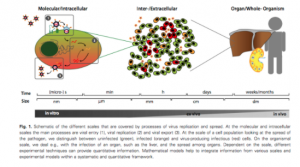Multiscale modeling of virus replication and spread.
Kumberger, Peter, et al. “Multiscale modeling of virus replication and spread.” FEBS letters (2016).
In the paper, the authors review the different modeling techniques used to determine and represent the processes of virus spread and replication spanning multiple scales. They focus on the viral infections of HIV-1 and HCV. Overall, they focus on how mathematical modeling has advanced our understanding of the pathogen’s life cycle.

The authors first focus on how viruses get into cells. Entering cells, viruses have to pass through two barriers. First, they have to get through the plasma membrane. Next, they must get through the actin cortex following the plasma membrane. Now that the virus is inside the cell, they use the intracellular transport system to get to the microtubule organizing center. When newly assembled viruses are ready to be released, they move towards the actin cortex. They exit through budding or exocytosis. All these processes have been invested through mathematical models and simulations.

The authors cover the standard model of viral dynamics (which is the model we covered in class). Here all the processes occurring within the cell (replication, packaging and transport) into parameter (p). The model represents the change in density of susceptible target cells (T), cells infected with the virus (I) and the viral load (V). The authors describe different uses of this model and some extensions (figure belows as an example). Using these typical models in combination of clinical data allows us to quantify intracellular processes of viral replication at the cellular level.

The presented model does not consider spatial spread of the virus or cell heterogeneity. Integrating these into the model can provide more insight in how the infection dynamics are affected. Also, these may also need to be integrated to analyze particular dynamics.

